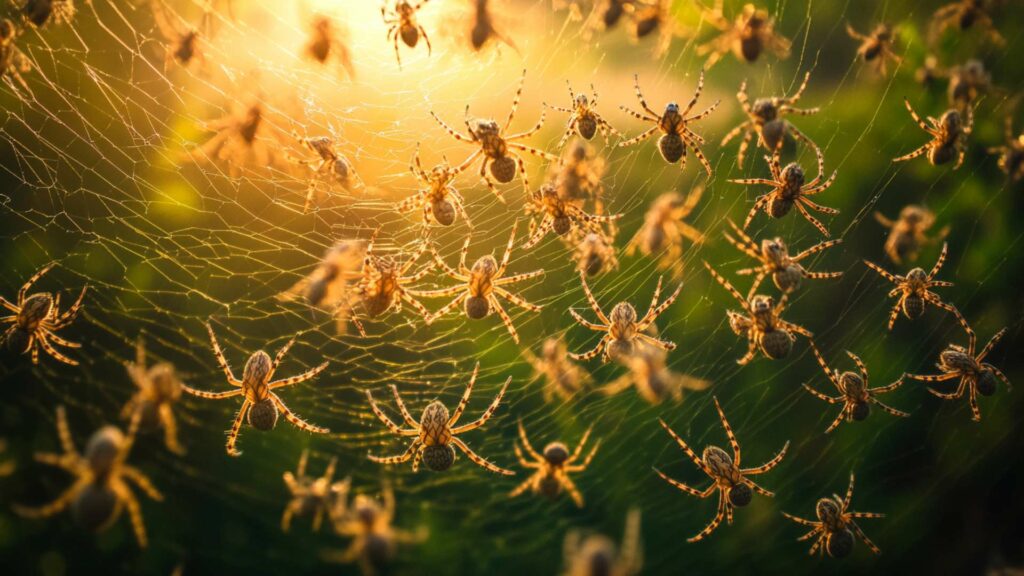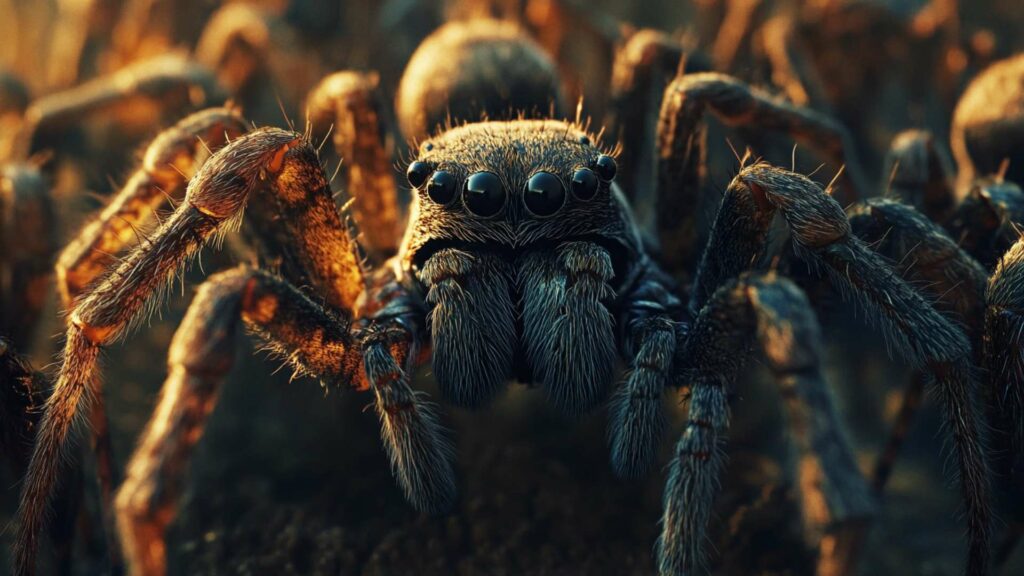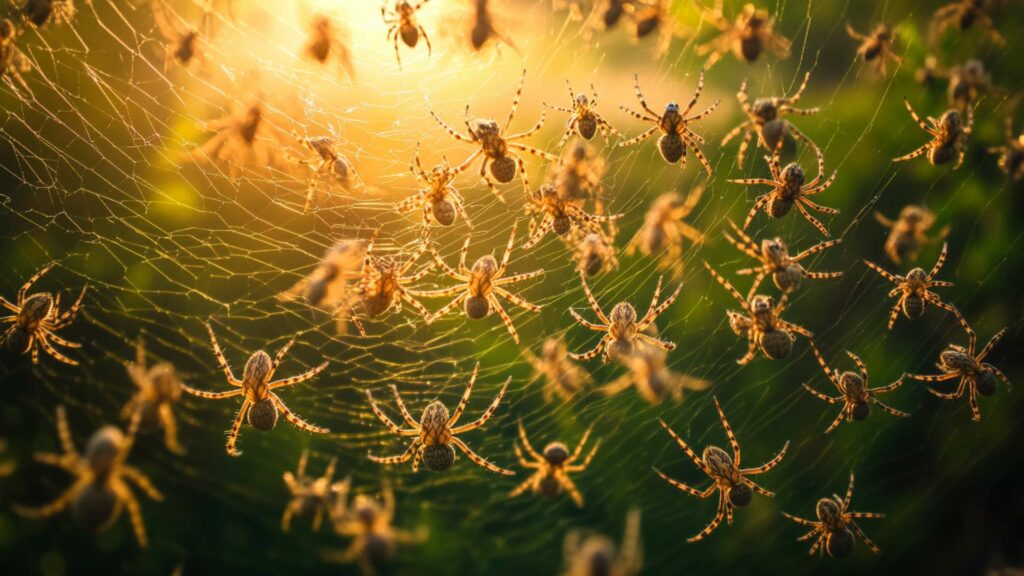Fascinating World of Jumping Spiders
Tiny Acrobats with Marvelous Moves Jumping spiders, as their name suggests, are a captivating group of arachnids that belong to the Salticidae family. These miniature acrobats are known for their incredible agility and mind-boggling leaps.
With over 6,000 species spread across the globe, jumping spiders have become one of the most diverse and fascinating groups within the spider kingdom. If you’ve ever observed a jumping spider up close, you’ll be captivated by their large, forward-facing eyes.
These eyes provide them with exceptional vision and depth perception. Combined with their remarkable ability to rotate their heads almost 360 degrees, they can swiftly track prey or predators alike.
It’s almost as if they possess a built-in surveillance system! But what truly sets them apart is their unique hunting technique – instead of relying on webs like many other spiders do, jumping spiders use their remarkable vision and agility to hunt actively.
Curiosity about Their Diet
What Sustains These Energetic Hunters? Given their nimble nature and impressive physical abilities, it’s only natural to wonder what fuels these tiny hunters’ boundless energy. So let’s delve into the intriguing world of jumping spider food diets.
As carnivores, jumping spiders primarily feed on insects and other small arthropods they encounter in their natural habitats. Flies, beetles, moths, butterflies wax worms – you name it; if it’s an insect within striking distance of a jumping spider’s agile leap or stealthy approach, it becomes a potential meal.
They are opportunistic predators who seize any chance to feast on unsuspecting prey that comes within reach. Interestingly enough, in addition to insects and arachnids like other spiders (yes – including other jumping spiders!), some species have even been known to occasionally indulge in a meal of small vertebrates.
While such instances are rare and usually observed in tropical regions, it’s not unheard of for a jumping spider to take down a small frog, lizard, or even the occasional bird or rodent. From hunting strategies to feeding habits, the world of jumping spiders is teeming with captivating details.
In subsequent sections, we will explore their main food sources, unique feeding habits, specialized adaptations for acquiring prey, and much more. So fasten your seatbelts as we embark on this journey into the fascinating diet of jumping spiders.
General Overview of Jumping Spider Diet

Carnivorous Nature
Jumping spiders, like many other spider species, are carnivorous creatures. This means that they primarily feed on other animals for sustenance.
While some spiders may incorporate plant material into their diet, jumping spiders solely rely on a protein-rich diet to obtain the necessary nutrients for their survival. Their carnivorous nature is evident in their hunting techniques and feeding habits, as they actively seek out, kill and capture prey to satisfy their dietary needs.
Varied Diet Depending on Species and Habitat
Jumping spider diets can vary significantly depending on the species and the habitat in which they reside. These adaptable arachnids demonstrate remarkable versatility in what they consume, allowing them to thrive in diverse environments across the globe. The specific prey items a jumping spider consumes can range from common insects such as flies, beetles, moths, and butterflies to larger arthropods like grasshoppers, crickets, and katydids.
Jumping spiders also display opportunistic feeding behavior by preying on ants, bees, wasps, and even other spiders including fellow jumping spider species. While small vertebrates are not typically part of baby jumping spiders eat as their regular diet, there have been rare instances where jumping spiders have been observed hunting small frogs or lizards in tropical regions.
Additionally, there have been occasional reports of these agile predators capturing small birds or rodents if given the opportunity. The varied diet of jumping spiders highlights their adaptability and resourcefulness when it comes to obtaining enough food to sustain themselves throughout their lifespan.
Whether it’s lurking patiently for unsuspecting prey or actively stalking potential victims using their exceptional vision before swiftly pouncing upon them with precision – these charismatic predators employ a diverse range of hunting strategies tailored to different circumstances. By capitalizing on available food sources within their habitat, jumping spiders ensure that they maintain a well-rounded and balanced diet necessary for their survival.
Main Food Sources for Jumping Spiders

Insects and other arthropods
Jumping spiders have a voracious appetite for insects fruit flies and other arthropods, making them quintessential carnivores. They are skilled hunters that can capture a wide range of small insects.
Whether it’s the buzzing flies, scuttling beetles, delicate moths, or vibrant butterflies, these agile predators are always on the prowl. Even though they are relatively small in size, jumping spiders have an incredible ability to overpower their prey.
Flies, beetles, moths, and butterflies
Flies are among the most common targets for jumping spiders due to their abundance. These nimble creatures can effortlessly catch flies mid-air with their lightning-fast reflexes and impressive jumping abilities.
Beetles also fall victim to the hunting prowess of jumping spiders. Their hard exoskeleton might make them seem like formidable opponents, but these arachnids easily overpower them with their venomous bite.
Moths and butterflies provide another delectable meal option for jumping spiders. With their fluttering wings and delicate bodies, they become irresistible temptations for these cunning predators who patiently wait for an opportune moment to strike.
Grasshoppers, crickets, and katydids
The energetic movements of grasshoppers make them challenging prey for many predators; however, jumping spiders tend to have no trouble hunting down these acrobatic insects.
Their exceptional vision enables them to accurately assess the precise moment to leap into action and secure a tasty meal. Crickets also fall within the menu of choice for many jumping spiders.
These musical insects become unsuspecting victims of adult spiders as they hop around in search of food or mates. Katydids with their leaf-like camouflage might sometimes evade detection by other predators but not by the sharp-eyed hunters that are jumping spiders.
Ants, bees, wasps, and spiders (including other jumping spiders)
Jumping spiders aren’t picky eaters when it comes to eating up their fellow arthropods. They will readily prey upon ants, bees, and wasps when given the opportunity.
Although these insects possess stingers or venomous defense mechanisms, they are no match for the agility and precision of jumping spiders. Even other species of spiders, including their own kind, may end up on the menu if they happen to cross paths with a hungry jumping spider.
Small vertebrates (rare occasions)
While insects and other arthropods form the staple diet of young jumping spiders everywhere, there have been rare occurrences where small vertebrates become their prey. In tropical regions especially, small frogs or lizards might occasionally end up in the clutches of these skilled hunters. Additionally, on very rare occasions when presented with an opportunity too enticing to resist, some adventurous adult jumping spiders have been known to target small birds or rodents.
The resourcefulness and adaptability of jumping spiders allow them to exploit various sources of food depending on their habitat and availability. Whether it’s hunting down small insects in intricate maneuvers or venturing into more unusual prey like frogs or birds when circumstances permit, these tiny yet formidable predators continue to surprise us with their diverse diet choices.
Hunting Techniques Employed by Jumping Spiders

Ambush hunting strategy: Patience and Camouflage
When it comes to hunting prey, jumping spiders are masters of strategy and deception. One of their common tactics is the ambush hunting strategy. These agile arachnids have exceptional patience, choosing to wait patiently for their prey to come within striking distance.
They carefully assess their surroundings, seeking out spots where they can blend seamlessly with their environment using their remarkable ability to camouflage. By adopting the colors and patterns of their surroundings, they become virtually invisible, waiting for the perfect moment to strike.
As they patiently lie in wait, jumping spiders remain alert and vigilant. Their keen eyesight allows them to detect even the slightest movement in their vicinity.
Once an unsuspecting insect draws near enough for a successful attack, the jumping spider springs into action with lightning speed and accuracy. It’s truly astonishing how these tiny predators can remain still for long periods while keeping a watchful eye on potential prey.
Active hunting strategy: Stalking and Pouncing
In addition to their patient ambush techniques, jumping spiders also employ an active hunting strategy that showcases their impressive agility and keen senses. With exceptional vision that rivals that of any predator in the animal kingdom, these arachnids are adept at stalking prey across various surfaces. Using their acute eyesight to track potential meals, jumping spiders stealthily move towards them with calculated precision.
They may inch closer step by step or plan surprising leaps depending on the circumstances. Once they are within striking distance, they pounce swiftly on unsuspecting victims with remarkable accuracy.
It’s fascinating to observe how these small creatures can maneuver effortlessly during an attack without losing sight of their target or falling off precarious perches. Their quick reflexes and agile movements make them formidable hunters in capturing live food necessary for survival.
Overall, whether employing an ambush or active hunting strategy, jumping spiders consistently showcase their ability to adapt and thrive in their quest for prey. Their combination of patience, camouflage, exceptional vision, and lightning-fast reflexes make them highly successful predators in the vast world of insects.
Unique Feeding Habits of Jumping Spiders
Envenomation Process
Jumping spiders employ a fascinating and dangerous feeding strategy that involves injecting venom through their fangs to immobilize their prey. When a jumping spider spots its target, it swiftly approaches and delivers a precise bite, injecting venom into the prey’s body. This venom serves two crucial purposes: immobilizing the victim and beginning the process of digestion.
The composition of the venom can vary across different species of jumping spiders, with some possessing more potent toxins than others. It is this envenomation process that allows jumping spiders to overcome their often larger and stronger prey, ensuring a successful hunt.
Liquid Diet Preference
Once the prey has been immobilized by the venom, jumping spiders exhibit a unique preference for liquid food consumption. After biting their victims, these agile hunters use specialized digestive enzymes to break down the body fluids of their prey. By liquefying the internal organs and tissues of insects, worms, or other small arthropods, they create a nutritious meal that can be easily consumed by these pint-sized predators.
Instead of chewing solid matter like many other spider species do, jumping spiders feed on liquidized remains. This liquid diet preference is advantageous for several reasons.
Firstly, it allows juvenile jumping spiders to feed on smaller insects since they don’t need to physically chew through exoskeletons or tough tissues. Additionally, consuming liquidized prey provides efficient access to essential nutrients while minimizing energy expenditure during digestion.
It’s important for pet owners who keep jumping spiders as pets to understand this unique feeding habit and ensure an appropriate diet is provided—such as small live insects like crickets or mealworms—which mimics their natural hunting behavior. Understanding the unique feeding habits of jumping spiders sheds light on how these remarkable creatures thrive in their environment.
From employing an envenomation process to immobilize prey, to their preference for a liquid diet that allows for efficient nutrient uptake, these spiders have evolved fascinating strategies to secure their meals. So, the next time you spot a jumping spider in action, marvel at its incredible hunting skills and appreciate the intricacies of what jumping spiders eat.
Specialized Adaptations for Acquiring Prey

Silk use during hunting
Jumping spiders, with their incredible ability to produce silk, employ this remarkable adaptation during their hunting endeavors. One of the primary uses of silk is the creation of a “silk drag” or “dragline.” When a jumping spider is on the prowl, it will release a strand of silk as it moves along, leaving a trail behind. This silk drag serves multiple purposes in their hunting strategy.
Firstly, it acts as an anchor in case they miss a leap or need to retreat quickly. Secondly, it helps them navigate back to their original location if they wander too far from home.
And perhaps most importantly, the silk drag allows them to sense vibrations and movements in their surroundings through specialized sensory hairs on their legs called trichobothria. This helps them detect potential prey or predators nearby.
Conclusion
Jumping spiders exhibit fascinating specialized adaptations that allow them to successfully acquire prey. Their use of silk during hunting provides them with essential tools for navigation, anchoring, and sensory perception.
These resourceful creatures demonstrate remarkable agility and intelligence as they employ various techniques to catch food and ensure their survival. The world of jumping spiders is truly captivating; these small arachnids prove that there is so much more complexity and diversity within the natural world than meets the eye.
So next time you come across a pet jumping spider in pet stores or encounter one in your own backyard, marvel at its incredible hunting abilities and appreciate the vital role they play in maintaining ecological balance by keeping populations of insects such as flies, beetles, moths, ants under control while providing important nutrients through their liquid diet. Let us celebrate these tiny wonders that bring vibrancy and life to our environment!
Achieve victory over spiders with D-Termination: Las Vegas’ foremost Pest Control solution!

Troubled by spider presence within your Las Vegas property? Look no further than D-Termination. Our team of experts excels at eradicating spider infestations, reinstating a sense of calm and serenity to your surroundings. Bid farewell to spiders—opt for D-Termination’s impactful pest control today!
Get in touch at 702-919-6310 or visit dtermination.com to schedule your spider control service and regain your space from these unwelcome intruders.
Frequently Asked Questions:
Jumping spiders are typically fed every few days.
Jumping spiders mainly eat insects, not fruit.
Jumping spiders need food, water, suitable shelter, and a proper environment to survive.
An active and hungry jumping spider may display more movement and hunting behavior.








